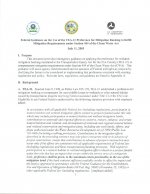Encouraging Voluntary Initiatives for Corporate Greening
Robert GibsonNone of the usual options the market, conventional regulatory authority and customary propriety can meet the challenge of moving toward sustainability in a dynamic, globalizing political economy. At least they cannot do so as usually applied and haphazardly associated. Efforts to build a coherent and well integrated set of motivations for “voluntary initiatives” […]
Les mesures compensatoires des atteintes à la biodiversité
Compensatory measures for impacts on biodiversity
Delphine MORANDEAU - Jean PLATEAUDelphine Morandeau and Jean Plateau from the Ministère de lÉcologie, de lÉnergie, du Développement durable et de la Mer – En charge des Technologies vertes et des négociations sur le climat, presented to the working group on Infrastructure and sustainable development on April 15, 2010. The Sustainable Development Department of the Caisse des Dépôts brougtht […]
Biodiversity Offsets A Further Update On The Law
Mark Christensen - Anderson Lloyd LawyersAn update on developments related to biodiversity offsets and environmental compensation in New Zealand. The author examines a number of key issues, previously the subject of considerable debate, now characterized as appearing to have been settled, through the decisions taken by the Environment Court and Boards of Inquiry on five cases.
Where is the avoidance in the implementation of wetland law and policy?
Shari Clare , Naomi Krogman, Lee Foote, Nathan LemphersAbstract Many jurisdictions in North America use a mitigation sequence to protect wetlands: First, avoid impacts; second, minimize unavoidable impacts; and third, compensate for irreducible impacts through the use of wetland restoration, enhancement, creation, or protection. Despite the continued reliance on this sequence in wetland decision-making, there is broad agreement among scholars, scientists, policymakers, regulators, […]
International Approaches to Compensation for Impacts on Biological Diversity
International Approaches to Compensation for Impacts on Biological Diversity
Leibniz Institute of Ecological and Regional Development and Berlin University of TechnologyThe starting point of this research project is the UN Convention on Biological Diversity (CBD). Through the ratification of the CBD, member countries have made a commitment to support the conservation of biological diversity. In the sixth Environment Action Programme 2001 2010 (Our Future, Our Choice) the European Union established the preservation of biodiversity […]
Environmental Offsets: Position Statement No 9
Government of AustraliaIn recent decades, there have been several attempts at developing and using environmental offsets as an environmental management tool in Western Australia (WA). For example, in the 1980s and 1990s government agencies attempted to counter adverse environmental impacts to Swan Coastal Plain wetlands by creating, conserving or enhancing wetlands elsewhere.
Application of NATURA 2000 in the Marine Environment
European UnionShort contributions from the participants illustrated that Member States have made very different progress in the identification and selection process of marine sites for NATURA 2000. The meeting had to recognize that overall the implementation is making very slow progress. On one hand only very few pure marine sites have been selected so far, many […]
Mining and Biodiversity: Rehabilitating Coal Mine Sites
John RolfeConcerns about environmental impacts have become widespread over the past four decades. In most of regional Australia, these concerns have focused on the activities of the agricultural and mining industries, as these are often the only economic activities in many regions.
Non-BBOP Compensatory Conservation Case Studies – 2009
Susie Brownlie - BBOPA summary of non-BBOP biodiversity offset case studies. Published in 2009.










